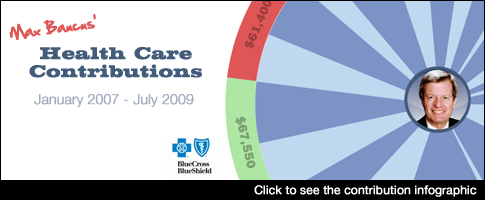Shining a Bright New Light on an Old Game
Jaws dropped around the Sunlight offices a couple of weeks ago, when we discovered after a month’s worth of painstaking research the extent to which lobbyist donations were echoing, and in some cases greatly supplementing, the campaign contributions of their clients.
We suspected there would be plenty of lobbyists giving money in concert with the organizations they represent, but we had no idea that we’d find cases where one, two or three dozen lobbyists gave to the same member as their clients.
Yet discoveries like that are just the sort of things that tend to pop to the surface when you take a fresh look at an old phenomenon, which is what Sunlight did with this collaborative investigative project with the Center for Responsive Politics.
The job of tracking lobbyist contributions has been a tricky one even since the Center for Responsive Politics first started categorizing campaign money more than 20 years ago. Because lobbyists have so many clients, often from different industries, the only way to logically classify their contributions was to list them simply as “lobbyists.”
While that made it possible to track the total impact of their personal contributions, it also split the lobbyists from the clients they represent. Thus, a lobbyist for a big drug manufacturer would be counted under “lobbyists,” not “healthcare.”
There had to be a better way to account for their real impact, and finally we came up with one. By combining the contribution databases with the lobbyist databases–records that simply didn’t exist 20 years ago–we could finally begin to investigate the connections between the lobbyists and their clients to see if they were giving in concert.
To do it right, we first had to find all the lobbyists. Since the great majority of federally registered lobbyists live in and around Washington, we started by examining all campaign contributions from residents of DC, Maryland, Virginia and West Virginia, from January 2007–the start of the 2007-2008 election cycle–through the latest available data in the 2009-2010 election cycle.
Then, with the help of a matching program developed by CRP, we examined each contribution by hand, weeding out donors with similar names, identifying spouses who also contributed, and finally linking the lobbyist donors with their clients from the lobbyist database. When that was complete, we then cast a wider net, checking whether any of the lobbyists we’d identified had also given contributions from outside the DC area.
The final step was reviewing all PAC and individual contributions to each member of Congress since 2007 and finding every case where both the lobbyist and their client gave money to the same member of Congress during that two-and-a-half year period.
That was when we discovered the size of the ‘bundles’ something that had previously been invisible. We began the investigation by looking at organizations in the health and insurance industries, since healthcare is the number one issue on Capitol Hill at the moment, but the research we’ve now completed will enable us to expand to other industries as well.
Don’t assume for a minute that we’ve found a new golden bullet that fully explains the role of lobbyists in Washington. Giving direct contributions is only one of many ways that lobbyists win friends and influence people on Capitol Hill. Hosting fundraisers is another, as is advising clients on how best to spread their PAC contributions.
But this research has given us a much more rounded view of the financial clout that lobbyists can bring to bear for their friends in the Capitol. After all, most lobbyists give only nominal amounts of money directly to members of Congress. The big money comes from their clients.
Now, for the first time, we’re poised to track it.
Much credit for the timeliness of this project goes to the amazingly hard-working staff of the Center for Responsive Politics, who had to pull a full court press of their own over the past two weeks to get this information out the door. Besides executive director Sheila Krumholz, a small army of researchers toiled to dig through the data especially Jihan Andoni, Susi Alger, Matthias Jaime, Dave Levinthal, Douglas Weber, Hector Rivera, Dan Auble, Carolyn Sharpe, Erin Williams, Lindsay Renick Mayer, Michael Becker and Ben Pilkerton.
On the Sunlight side of the street, the heavy lifting behind the scenes was done by Kerry Mitchell–who did our visualization–Gabriella Schneider, Noah Kunin, Luke Rosiak, Anupama Narayanswamy and Bill Allison. The green light to get the project rolling in the first place came from the same place it usually does at the Sunlight Foundation: executive director Ellen Miller, without whom none of this information would have ever seen the light of day.
Stay tuned–this first release is just the tip of the iceberg; there’s much more to come.


